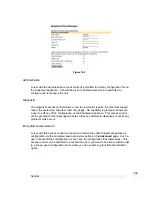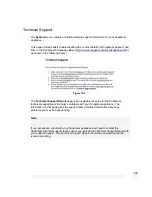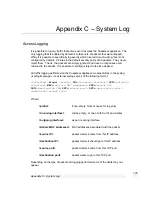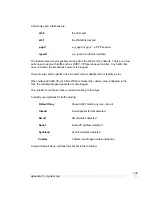
Appendix B – Terminology
172
Net mask
The way that computers know which part of a TCP/IP address refers to
the network, and which part refers to the host range.
NTP
Network Time Protocol (NTP) used to synchronize clock times in a
network of computers.
Oakley Group
See Diffie-Hellman Group or Oakley Group.
PAT
Port Address Translation. The translation of a port number used on
one network to a port number on another network.
PEM, DER,
PCKS#12
PCKS#07
These are all certificate formats.
Perfect Forward
Secrecy
A property of systems such as Diffie-Hellman key exchange which use
a long-term key (such as the shared secret in IKE) and generate short-
term keys as required. If an attacker who acquires the long-term key
provably can neither read previous messages which he may have
archived nor read future messages without performing additional
successful attacksthen the system has PFS. The attacker needs the
short-term keys in order to read the traffic and merely having the long-
term key does not allow him to infer those. Of course, it may allow him
to conduct another attack (such as man-in-the-middle) which gives him
some short-term keys, but he does not automatically get them just by
acquiring the long-term key.
Phase 1
Sets up a secure communications channel to establish the encrypted
tunnel in IPSec.
Phase 2
Sets up the encrypted tunnel in IPSec.
PPP
Point-to-Point Protocol. A networking protocol for establishing simple
links between two peers.
PPPoE
Point to Point Protocol over Ethernet. A protocol for connecting users
on an Ethernet to the Internet using a common broadband medium
(e.g. single DSL line, wireless device, cable modem, etc).
PPTP
Point to Point Tunneling Protocol. A protocol developed by Microsoft™
that is popular for VPN applications. Although not considered as
secure as IPSec, PPP is considered "good enough" technology.
Microsoft has addressed many flaws in the original implementation.
Preshared secret
A common secret (passphrase) that is shared between the two parties.
Quick Mode
This Phase 2 keying mode automatically exchanges encryption and
authentication keys that actually establishes the encrypted tunnel.
Rekeying
The process of renegotiating a new set of keys for encryption and
authentication.
Road warrior
A remote machine with no fixed IP address.
Router
A network device that moves packets of data. A router differs from
hubs and switches because it is "intelligent" and can route packets to
their final destination.



































